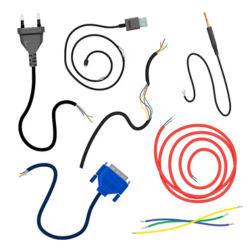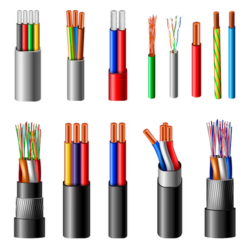Table of Contents
When it comes to installing electrical systems in homes, offices, or industrial settings, selecting the right type of wire and cable is crucial for ensuring safety, efficiency, and compliance with building codes. This guide will introduce you to the various types of electrical wires and cables, explaining their features, uses, and key considerations. Whether you’re a DIY enthusiast or a professional, understanding the differences between these components will help you make informed decisions for your electrical projects.
Wire vs. Cable: What's the Difference?
While the terms “wire” and “cable” are often used interchangeably, they refer to different things in the electrical world.
- Wire: A single electrical conductor, typically made of copper or aluminum, that may or may not be insulated.
- Cable: A collection of multiple wires that are twisted, braided, or bonded together and encased in an outer sheath for protection.
Understanding these differences helps in selecting the appropriate product for specific applications, ensuring that the wire or cable performs as needed while complying with safety standards.

Types of Electrical Wires
Copper Wires
- Description: Copper is the most commonly used material for electrical wiring due to its excellent conductivity, which reduces energy loss during transmission.
- Insulation: These wires are typically insulated with materials such as PVC or thermoplastic, offering resistance to heat and moisture.
- Applications: Commonly used in both residential and commercial wiring, including light fixtures, outlets, and general-purpose circuits.
Aluminum Wires
- Description: Although aluminum wire is more conductive than copper, it degrades faster over time, making it less ideal for household electrical installations.
- Usage: It is more common in older installations or high-voltage transmission lines. Due to its faster degradation, aluminum wiring should be handled by professional electricians.
- Safety Tip: Always ensure aluminum wiring is correctly installed to avoid safety hazards, as it can be prone to overheating.
THHN/THWN Wires
- Description: These are thermoplastic wires, widely used for general electrical wiring. “T” stands for thermoplastic insulation, “H” for heat resistance, “W” for wet location rating, and “N” for nylon-coated wire.
- Features: Suitable for temperatures up to 75°C for THHN and up to 90°C for THWN.
- Applications: These wires are ideal for indoor and outdoor residential, commercial, and industrial applications where moderate heat resistance is necessary.
Grounding Wires
- Description: Typically colored green or bare, these wires serve as a safety feature to carry any stray current safely into the ground, reducing the risk of electrical shock.
- Applications: Used in all electrical systems to provide a path for fault currents and prevent electrical shocks.
High-Temperature Wires
- Description: These wires are designed to withstand higher temperatures than standard wires. They are coated with materials such as silicone or fiberglass.
- Applications: Suitable for environments where extreme heat is expected, such as in ovens, furnaces, or machinery.
Types of Electrical Cables
NM-B (Non-Metallic-Sheathed) Cable
- Description: This type of cable consists of two or more insulated wires (typically copper or aluminum) wrapped in a flexible plastic sheath.
- Applications: Commonly used for indoor residential wiring, including lighting circuits, outlets, and home appliances. It’s a cost-effective solution for home wiring, but not recommended for outdoor or underground use.
UF (Underground Feeder) Cable
- Description: UF cable is designed for underground installations and features a solid thermoplastic sheath that protects the wires from moisture, heat, and physical damage.
- Applications: Used for outdoor installations, including feeders for landscape lighting, outdoor outlets, and underground wiring.

AC (Armored Cable)
- Description: AC cable, also known as BX cable, is encased in a metal sheath that acts as a ground and protects the internal wires from physical damage.
- Applications: Often used in older homes or buildings where a metal shield is needed for additional protection. It’s best for indoor use, especially in environments where the wiring might be exposed to physical damage.
Metal-Clad Cable
- Description: Similar to armored cable, but with plastic insulation instead of paper. This type of cable is typically used for industrial and commercial purposes.
- Applications: Suitable for environments where both fire and mechanical damage resistance are needed.
Coaxial Cable
- Description: Coaxial cable is used to carry data and video signals, such as in televisions and internet connections. It features a central conductor, an insulating layer, a metallic shield, and an outer insulating layer.
- Applications: Commonly used for cable TV, internet connections, and security cameras.
HDMI Cable
- Description: High-Definition Multimedia Interface (HDMI) cables are used for transmitting digital video and audio signals in high definition.
- Applications: Used in modern home entertainment systems to connect TVs, Blu-ray players, gaming consoles, and other devices.
Speaker Cable
- Description: This type of cable is used to connect loudspeakers to audio amplifiers.
- Applications: Ideal for home theaters, PA systems, and audio equipment.
Understanding Electrical Wire and Cable Sizing
For instance:
- 14 AWG: Suitable for light fixtures and household receptacles.
- 12 AWG: Ideal for small appliances and lighting circuits.
- 10 AWG: Used for larger appliances like air conditioners or dryers.
When selecting wire for a project, always factor in the expected amperage and voltage. For longer wire runs, it’s recommended to use a wire with a lower gauge to ensure that enough electricity can pass through it.
Conclusion
Selecting the correct type of electrical wire and cable for your project is essential for ensuring safety and efficiency. By understanding the differences between wire and cable types, as well as the appropriate uses for each, you can make more informed decisions when planning your electrical installations. Always ensure that your electrical projects comply with local building codes and safety standards, and consult with a professional if you’re unsure about any aspect of your wiring installation.
For all your electrical wiring needs, it’s important to choose a trusted source that offers high-quality products. If you’re based in Delhi, you can rely on Capital Cables for all your Polycab wire and cable needs, ensuring your installations are safe, reliable, and up to code.
Table of Contents


